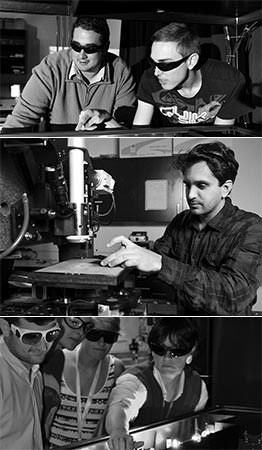Facilities
 Our advanced materials research relies heavily on highly sophisticated instruments.
Our advanced materials research relies heavily on highly sophisticated instruments.
These transformational tools allow us to achieve amazing leaps forward in new discoveries, real-world applications and marketable innovations. They strengthen our national and international collaborations as many are available to investigators outside the institute. They are also a drawcard for top PhD and postdoc students and open up exciting career channels.
For more information on the instruments below, contact the relevant investigator.
1 Tesla vibrationing sample magnetometer (VSM)
For magnetic field loops (+/- 1 Tesla) and temperature dependent magnetisation from 20 to 310 K. We also have a magneto-electric test-rig that can run on the 1 Tesla electromagnet.
Analytical ultracentrifugation
Size and shape determination of nanoparticles, such as proteins, quantum dots etc, through sedimentation in solutions (usually aqueous, but can be anything).
Ar ion mill
For physical milling/patterning of thin film structures into patterned devices using a beam of Ar ions.
Atomic force microscope
Nanosurf FlexAFM atomic force microscope (AFM). Contact and tapping modes including: conductive, magnetic, piezoresponce.
Atomic force microscopy and magnetic force microscopy
Can do atomic force microscopy, magnetic force microscopy and piezoelectric force microscopy.
Biological applications laboratory
For fabrication of microfluidic and Lab-on-a-Chip devices using photo- and soft-lithography, micro-milling, and their characterization and application to live cell and microorganism culture in combination with fluorescence and confocal microscopy.
CD micro-spectrometer
Custom-built spectrometer system with intense broadband white light (UV-near-IR), alternating circular polarisation, high-NA microscope objectives, and spectrometer with CCD and PMT detectors for absorbance, fluorescence, Raman measurements of optical activity.
Cleanroom fabrication facility
Equipment suite for the fabrication of microelectronic devices. Includes photolithography evaporation, sputter coating, oxygen plasma etching and electrical testing.
Cluster deposition system
This purpose-built system provides a capability to deposit nanoparticles of controlled sizes and to measure the electrical properties of devices fabricated using the nanoparticles as building blocks.
Dynamic microfluidics laboratory
High-speed cameras, lighting, lenses etc. optimised for visualising droplet-scale microfluidics experiments.
Electrochemical instrumentation
We have an extensive suite of electrochemical instrumentation to perform variety of electrochemical analyses.
Electrochemistry facility
A wide range of potentiostats capable of common electrochemical techniques like cyclic voltammetry and impedance spectroscopy. Current ranges from 100 femtoamps to 10 Amp. Also rotating disc and ring-disc electrodes, electrochemical quartz crystal microbalance, photoelectrochemical set-up and online gas chromatography (coupled to electrochemical cells).
Electron beam annealing
Vacuum annealing system using a medium energy (30 keV) electron beam to heat inorganic samples up to 1,200° C.
Emulsion formation and characterisation facility
Mechanical mixers and ultrasound probe for preparing colloid dispersions and static light scattering, bulk rotational rheometers, interfacial rheolometer, microscopy and interfacial tensiometry equipment for characterising them.
Field emission measurement
Vacuum chamber to undertake field emission measurements.
Gas absorption analyzer
For measuring the uptake of gases by porous materials, for example to determine the BET surface area or their affinity for various guests
Gas separation analyzer
For measuring the performance of membranes or porous materials in separating gas mixtures.
Hall probe
Four point probe to measure conductivity, carrier concentration and mobility.
Inert atmosphere glovebox
For synthesis and manipulation of materials under an inert atmosphere.
Ion beam analysis facility
3 MV Van de Graaf accelerator and beamlines to undertake a range of ion beam analyses including: Rutherford backscattering spectrometry (RBS), particle induced X-ray emission (PIXE), nuclear reaction analysis (NRA), elastic recoil detection (ERD). Provides elemental and structural characterization.
Ion beam sputter deposition
Thin film deposition equipment using 20 kV accelerated inert gas beam to sputter atom from a target onto samples to be coated.
Ion implantation facility
Undertake ion implantation with acceleration voltages ranging from 1 to 60 keV in 1 cm2 size sample.
Low and high field NMR facility
Facility for material characterisation using NMR spectroscopy, diffusometry and imaging.
Low-temperature vacuum cryostat
Vacuum cryostat with 20x20 cm sample stage, currently set up for thermopower and resistivity measurements down to 5 K.
MOKE (magneto-optical Kerr effect) microscope
For imaging magnetic domains of materials and measuring magnetisation loops with magnetic fields both in-plane and out-of-plane using polarised light at ambient and cryogenic conditions.
Nanopipetting equipment
Equipment for making, positioning, and transducing through nanopipettes. Can be adapted for functions such as scanning ion conductance microscopy, resistive pulse sensing, and soft particle mechanical measurements.
Optical lithography laboratory
The combination of a basic mask aligner, spinner, evaporator etc provide capability for simple lithographic processing with resolution down to about 1 µm.
Optical tweezers
Optical tweezers use focussed laser beams to manipulate microscopic particles and measure forces at the nm and pN scales, for example colloidal interactions and single molecule stretching.
Raman laboratory (VUW)
Raman spectrometers: Raman microscopes with multiple laser excitations, time-resolved (ms) and scanning/mapping capabilities. Combined absorption/extinction UV/Vis spectrophotometer for measuring turbid samples.
Raman microscope
For using Raman microscopy to examine distribution and variations in composition over an area, with micron to sub micron resolution.
Raman spectroscopy (custom-built)
Raman spectroscopy facility including low-frequency, spectroelectrochemical, and high pressure measurements.
Raman spectroscopy systems
For recording the vibrations spectrum of system using a wide range of Raman spectroscopy techniques, including Resonance Raman, low-frequency Raman, time-resolved Raman and non-resonant Raman spectroscopies.
Scanning tunnelling microscope / atomic force microscope
Omicron variable temperature STM/AFM provides a capability for atomic resolution imaging and scanning tunnelling spectroscopy of nanostructures and surfaces.
Six-target magnetron thin film sputtering system
For depositing thin films and multilayers by magnetron sputtering in ultra-high vacuum - optimised for spintronic structures such as GMR or TMR junctions.
SPR
Custom-built surface plasmon resonance setup. Can also be combined with Raman spectroscopy.
Transient absorption and emission
For measuring the excited state dynamics on the nano to micro second timescales via transient absorption and phosphorescence spectroscopies.
Ultrafast optical spectroscopy facility
For measuring excited state dynamics on ultrafast timescales via transient absorption, fluorescence, stimulated Raman, and time-domain terahertz spectroscopies.


